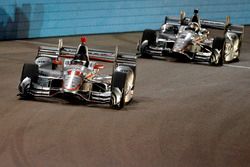2018 IndyCar details to be revealed “in next 30 days”
Jay Frye says next year’s Indy car will begin testing in June or early July, but that he expects to be able to confirm the test program’s details between the season-opening race at St. Petersburg and Round 2 at Long Beach.

Photo by: IndyCar Series













IndyCar’s president of competition and operations said that the composition of the independent test team, the identity of the aerokit designer and manufacturer, and the testing schedule, will be revealed within the next month.
He told Motorsport.com: “One of the things we want to make sure of is having huge collaboration within the teams and the manufacturers and suppliers. In the next 30 days – somewhere between St. Pete and Long Beach we will be a lot more clear and have a final path forward, a timeline, regarding who’s going to be involved in the testing, where it will be tested.
“We’ve got it tentatively resolved. It’s all becoming clearer quickly, but there are still some pieces we’re juggling and in the next couple of weeks we’ll have a clearer idea.”
Frye said that the concept and modeling of the new car had gone smoothly to date and with the full cooperation of the teams and manufacturers. However, he said in order to maintain that spirit, they would likely need to start testing two cars, one with a Chevrolet engine, one with a Honda.
“So far so good,” he commented. “There have been no hiccups to date and there’s been a lot of good learning. Transferring the downforce to the bottom of the car, there have been a lot of exciting discoveries both in terms of safety and performance.
“But I would say we’re more likely to launch two cars to make sure everyone’s involved from the start, and no one feels like they’re out of the loop. We have a lot of smart people in the paddock, and the more input we have, the better. Manufacturers, teams, suppliers, and drivers. There’s great enthusiasm to be part of this. Let’s take advantage of that and speed up the learning process.”
Improving car safety in 2018 and 2019
On the subject of overhead cockpit protection, a much-debated halo/aeroscreen alternative is, according to Frye, being “simultaneously developed along with the 2018 car, but it hasn’t been determined on what precisely it will be or what it looks like.
“But we’re aiming to have it ready to go – or close to ready to go so that it’s possible to run late in ’18 or beginning in ’19. There’s a step in the development process where you test the car with and without the screen, because anything you add will have an effect on the car’s performance.”
Regardless of the aeroscreen addition, Frye stated that the IndyCar will be taking a big step forward in terms of driver protection in 2018.
He said: “The aspect of safety that perhaps hasn’t been emphasized enough is that there will be a lot fewer parts on the 2018 car that would create debris, which is a huge goal achieved.
“We’ve made a lot of progress with the current car regarding tethers, but the 2018 car will take it to the next level in terms of not having so many individual pieces that require tethering.”
Unveiling the car to the public
Frye had recently commented that the need of the 2018 car’s independent test team would govern when the car will be unveiled, and emphasized that he wanted the car to be truly illustrative of what will be raced on track next season.
He said: “We can’t wait to unveil this car to the fans, and we’d be thrilled to do it at some point around the Indy 500. But we want what we show to be as representative as possible of what we will have next year, and initially there’s only going to be so many parts and pieces to go test this car.
“We’ve got to make sure we’re ready to go test 30-45 days after the 500 and if it’s an either/or situation between showing a car and testing it then testing has to take priority. So I’m just unveiling at Indy in May could be optimistic – I’m not sure yet.
“Everything can look great on paper and in simulations and windtunnels and so on, but if we test and find we need to make adjustments in the real world, then that’s what we’ll do. Fortunately everything we’ve seen in modeling has been really good, even exceeded our expectations in certain key areas, but we may still need to reconfigure certain aspects.
“The point is, we want the fans to see something we can guarantee to be very close to the finished product rather than just a concept that could change.”
Be part of Motorsport community
Join the conversationShare Or Save This Story
Subscribe and access Motorsport.com with your ad-blocker.
From Formula 1 to MotoGP we report straight from the paddock because we love our sport, just like you. In order to keep delivering our expert journalism, our website uses advertising. Still, we want to give you the opportunity to enjoy an ad-free and tracker-free website and to continue using your adblocker.















Top Comments